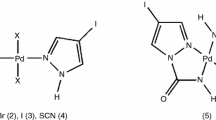Abstract
The pyridyl complextrans-[PdCl{C5H3N(6-Cl)-C 2}(PPh 3)2] easily undergoes insertion of isocyanides into the palladium—carbon bond via an ionic intermediate to give the title compounds. Details on the insertion pathway were obtained through IR,31P-NMR and conductivity measurements. The presence of the NCCN moiety in the resulting imino(2-pyridyl)methyl palladium(II) complexes is supported by formation of an 1:1 adduct with CuCl2.
Zusammenfassung
Der Pyridyl-Komplextrans-[PdCl{C5H3N(6-Cl)-C2} (PPh 3)2] geht leicht — über eine ionische Zwischenverbindung — eine Isocyanid-Insertionsreaktion in die Pd-C-Bindung ein und ergibt dabei die Titelverbindungen. Details über den Ablauf dieser Insertion wurden durch IR,31P-NMR und Leitfähigkeitsmessungen erhalten. Die Gegenwart von NCCN in den resultierenden Imino(2-pyridyl)methyl-palladium(II)-Komplexen wird durch die Bildung eines 1:1-Addukts mit CuCl2 unterstützt.
Similar content being viewed by others
References
Crociani B., Mantovani A., Scrivanti A., J. Organomet. Chem.233, 387 (1982), and references therein.
Crociani B., Nicolini M., Mantovani A., J. Organomet. Chem.177, 365 (1979).
Yamamoto Y., Yamazaki H., Inorg. Chem.13, 438 (1973).
Treichel P. M., Hess R. W., J. Amer. Chem. Soc.92, 15 (1970).
Geary W. J., Coord. Chem. Rev.7, 81 (1971).
Otsuka S.,Ataka K., J. Chem. Soc., Dalton Transaction1976, 327.
Treichel P. M., Wagner K. P., Hess R. W., Inorg. Chem.12, 1471 (1973).
Isobe K.,Nanjo K.,Nakamura Y.,Kawaguchi S., Chem. Lett.1979, 1193.
Mantovani A., J. Organomet. Chem., in press.
Appel R., Kleinstuck R., Ziehn K. D., Angew. Chem., int. Ed.10, 132 (1971).
Author information
Authors and Affiliations
Rights and permissions
About this article
Cite this article
Mantovani, A. Organometallic complexes as ligands. Synthesis oftrans-\([||P\overline {dClC( = NR) \{ C_5 H_3 N(6 - Cl)---| } C^2 \} (PPh_3 )_2 ]\) (R=p—OMeC6H4,CH3,c-C6H11,Bu t) and new information on the isocyanide insertion into the Pd-C σ bond. Monatsh Chem 114, 1045–1051 (1983). https://doi.org/10.1007/BF00799028
Received:
Revised:
Accepted:
Issue Date:
DOI: https://doi.org/10.1007/BF00799028




